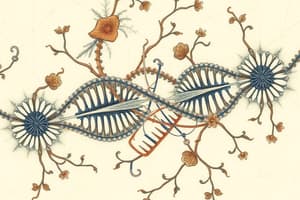Podcast
Questions and Answers
What is the purpose of selection in recombinant DNA technology?
What is the purpose of selection in recombinant DNA technology?
- To isolate the protein for further study
- To identify recombinant DNA molecules
- To grow cells under favorable conditions (correct)
- To detect specific DNA sequences
Which technique is commonly used for screening in recombinant DNA technology?
Which technique is commonly used for screening in recombinant DNA technology?
- DNA sequencing
- PCR (correct)
- Antibody resistance
- Protein purification
After cloning a gene, what step is necessary to produce the encoded protein?
After cloning a gene, what step is necessary to produce the encoded protein?
- Exposing cells to DNA in solution
- Introducing the recombinant DNA into the host organism (correct)
- Purifying the DNA sequence
- Screening for antibiotic resistance
Which method is NOT used for gene expression in recombinant DNA technology?
Which method is NOT used for gene expression in recombinant DNA technology?
What impact has recombinant DNA technology had on our world?
What impact has recombinant DNA technology had on our world?
What drives innovation and discovery in the life sciences regarding recombinant DNA technology?
What drives innovation and discovery in the life sciences regarding recombinant DNA technology?
What is the role of vectors in recombinant DNA technology?
What is the role of vectors in recombinant DNA technology?
Which tool is used to join DNA fragments into larger pieces?
Which tool is used to join DNA fragments into larger pieces?
What is the main function of restriction enzymes in recombinant DNA technology?
What is the main function of restriction enzymes in recombinant DNA technology?
Which type of molecule are plasmids commonly found in recombinant DNA technology?
Which type of molecule are plasmids commonly found in recombinant DNA technology?
What is the purpose of transformation in recombinant DNA technology?
What is the purpose of transformation in recombinant DNA technology?
Which tool is crucial for the precise manipulation of DNA fragments in recombinant DNA technology?
Which tool is crucial for the precise manipulation of DNA fragments in recombinant DNA technology?
Study Notes
Decoding the Tools of Recombinant DNA Technology
Recombinant DNA technology, often abbreviated as rDNA, has revolutionized biotechnology since its inception in the late 1970s. This groundbreaking field, which allows the manipulation of genetic material, relies on several key tools and techniques. This article will explore some of these tools, drawing from the careers and research experiences of biotechnology professionals.
Cloning Vectors
Vectors serve as vehicles to transfer DNA fragments between organisms. Commonly used vectors include plasmids (circular DNA molecules found in bacteria) and viruses (such as adenoviruses and bacteriophages). These vectors contain DNA sequences that can be recognized and replicated by host cells, ensuring the persistence and expression of the desired DNA fragment.
Restriction Enzymes
Restriction enzymes, also called endonucleases, are proteins that recognize and cleave DNA at specific sequences, creating sticky ends. These enzymes are essential for separating and inserting DNA fragments into vectors. The variety of available restriction enzymes allows for precise manipulation of DNA.
Ligation
Ligation is the process of joining DNA fragments into larger pieces. This is performed using enzymes called ligases, which form phosphodiester bonds between the sticky ends of DNA fragments.
Transformation
Transformation is the process by which living organisms (usually bacteria) take up and incorporate foreign DNA. This can be achieved by exposing cells to DNA in solution or by using viral or other vectors.
Selection and Screening
To identify recombinant DNA molecules, selection and screening techniques are employed. Selection involves growing cells containing recombinant DNA molecules under conditions that favor their survival, while screening involves detecting the presence of specific DNA sequences or products. Common selection methods include antibiotic resistance, while screening methods include the use of antibodies, PCR, and DNA sequencing.
Gene Expression and Purification
Once a gene has been cloned, it must be expressed in a suitable host organism to produce the encoded protein. This is achieved by introducing the recombinant DNA into the host organism and allowing it to synthesize the protein. Purification techniques are then used to isolate the protein for further study or use.
Recombinant DNA technology has had a profound impact on our world, allowing for the production of essential drugs, treatments for genetic disorders, and the advancement of research into various diseases. As the field continues to evolve, the development of new tools and techniques will drive innovation and discovery in the life sciences.
Studying That Suits You
Use AI to generate personalized quizzes and flashcards to suit your learning preferences.
Description
Discover the key tools and techniques behind recombinant DNA technology used in biotechnology. Learn about cloning vectors, restriction enzymes, ligation, transformation, selection and screening methods, and gene expression and purification processes.




